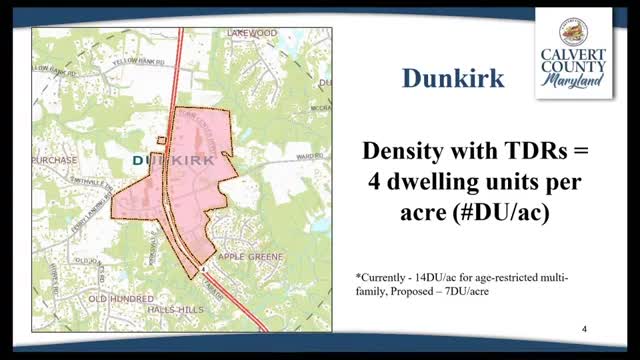Commissioners Debate Housing Density Amid Community Concerns
August 20, 2024 | Calvert County, Maryland
This article was created by AI summarizing key points discussed. AI makes mistakes, so for full details and context, please refer to the video of the full meeting. Please report any errors so we can fix them. Report an error »

In a recent government meeting, significant discussions centered around proposed changes to residential density regulations across various town centers in Calvert County. The Board of County Commissioners deliberated on reducing the maximum allowable density from 14 dwelling units per acre to a more conservative four units per acre, a move aimed at addressing community concerns over high-density developments.
The proposal, which is set to be finalized in a public hearing scheduled for December, seeks to standardize density limits across different areas, including Dunkirk, Owings, and Prince Frederick. Currently, Dunkirk allows four dwelling units per acre, while Owings has no maximum density, and Prince Frederick's density is proposed to drop from 14 to seven units per acre. The commissioners expressed a desire to revert to a more uniform density requirement, reflecting a commitment to maintaining the rural character of the county.
During the meeting, Commissioner Hart emphasized the need for a return to the previous standard of five transferable development rights (TDRs) per unit, arguing that the current system, which varies based on the type of housing, complicates the planning process and does not adequately address the impact of high-density housing on local infrastructure. The discussion highlighted concerns about the potential strain on public services, including schools and emergency services, as well as the environmental implications of increased development.
Public comments echoed these concerns, with residents expressing frustration over the rapid pace of development and the perceived lack of adequate infrastructure to support new housing projects. Several speakers called for stricter regulations and more thorough impact assessments for proposed developments, particularly in light of ongoing issues related to traffic and environmental sustainability.
The meeting concluded with a motion to amend the density proposal to four units per acre, unless existing regulations allow for lower densities. This motion reflects a broader trend among local governments to reassess zoning laws in response to community feedback and changing demographics.
As the county prepares for the upcoming public hearing, the discussions from this meeting underscore the ongoing tension between development needs and community preservation, a balancing act that will continue to shape the future of Calvert County.
The proposal, which is set to be finalized in a public hearing scheduled for December, seeks to standardize density limits across different areas, including Dunkirk, Owings, and Prince Frederick. Currently, Dunkirk allows four dwelling units per acre, while Owings has no maximum density, and Prince Frederick's density is proposed to drop from 14 to seven units per acre. The commissioners expressed a desire to revert to a more uniform density requirement, reflecting a commitment to maintaining the rural character of the county.
During the meeting, Commissioner Hart emphasized the need for a return to the previous standard of five transferable development rights (TDRs) per unit, arguing that the current system, which varies based on the type of housing, complicates the planning process and does not adequately address the impact of high-density housing on local infrastructure. The discussion highlighted concerns about the potential strain on public services, including schools and emergency services, as well as the environmental implications of increased development.
Public comments echoed these concerns, with residents expressing frustration over the rapid pace of development and the perceived lack of adequate infrastructure to support new housing projects. Several speakers called for stricter regulations and more thorough impact assessments for proposed developments, particularly in light of ongoing issues related to traffic and environmental sustainability.
The meeting concluded with a motion to amend the density proposal to four units per acre, unless existing regulations allow for lower densities. This motion reflects a broader trend among local governments to reassess zoning laws in response to community feedback and changing demographics.
As the county prepares for the upcoming public hearing, the discussions from this meeting underscore the ongoing tension between development needs and community preservation, a balancing act that will continue to shape the future of Calvert County.
View full meeting
This article is based on a recent meeting—watch the full video and explore the complete transcript for deeper insights into the discussion.
View full meeting
